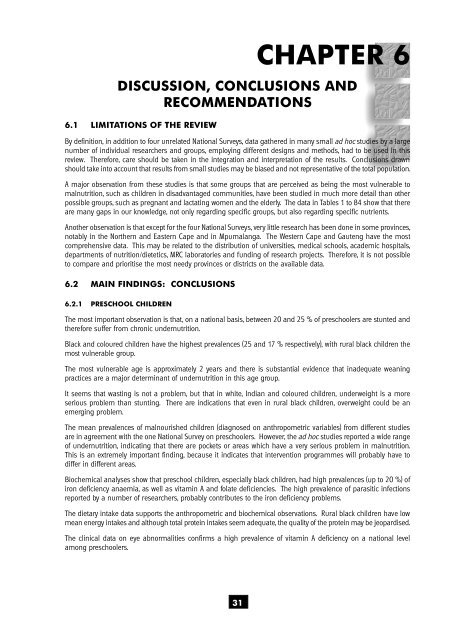the nutritional status of - Health Systems Trust
the nutritional status of - Health Systems Trust
the nutritional status of - Health Systems Trust
You also want an ePaper? Increase the reach of your titles
YUMPU automatically turns print PDFs into web optimized ePapers that Google loves.
CHAPTER 6<br />
DISCUSSION, CONCLUSIONS AND<br />
RECOMMENDATIONS<br />
6.1 LIMITATIONS OF THE REVIEW<br />
By definition, in addition to four unrelated National Surveys, data ga<strong>the</strong>red in many small ad hoc studies by a large<br />
number <strong>of</strong> individual researchers and groups, employing different designs and methods, had to be used in this<br />
review. Therefore, care should be taken in <strong>the</strong> integration and interpretation <strong>of</strong> <strong>the</strong> results. Conclusions drawn<br />
should take into account that results from small studies may be biased and not representative <strong>of</strong> <strong>the</strong> total population.<br />
A major observation from <strong>the</strong>se studies is that some groups that are perceived as being <strong>the</strong> most vulnerable to<br />
malnutrition, such as children in disadvantaged communities, have been studied in much more detail than o<strong>the</strong>r<br />
possible groups, such as pregnant and lactating women and <strong>the</strong> elderly. The data in Tables 1 to 84 show that <strong>the</strong>re<br />
are many gaps in our knowledge, not only regarding specific groups, but also regarding specific nutrients.<br />
Ano<strong>the</strong>r observation is that except for <strong>the</strong> four National Surveys, very little research has been done in some provinces,<br />
notably in <strong>the</strong> Nor<strong>the</strong>rn and Eastern Cape and in Mpumalanga. The Western Cape and Gauteng have <strong>the</strong> most<br />
comprehensive data. This may be related to <strong>the</strong> distribution <strong>of</strong> universities, medical schools, academic hospitals,<br />
departments <strong>of</strong> nutrition/dietetics, MRC laboratories and funding <strong>of</strong> research projects. Therefore, it is not possible<br />
to compare and prioritise <strong>the</strong> most needy provinces or districts on <strong>the</strong> available data.<br />
6.2 MAIN FINDINGS: CONCLUSIONS<br />
6.2.1 PRESCHOOL CHILDREN<br />
The most important observation is that, on a national basis, between 20 and 25 % <strong>of</strong> preschoolers are stunted and<br />
<strong>the</strong>refore suffer from chronic undernutrition.<br />
Black and coloured children have <strong>the</strong> highest prevalences (25 and 17 % respectively), with rural black children <strong>the</strong><br />
most vulnerable group.<br />
The most vulnerable age is approximately 2 years and <strong>the</strong>re is substantial evidence that inadequate weaning<br />
practices are a major determinant <strong>of</strong> undernutrition in this age group.<br />
It seems that wasting is not a problem, but that in white, Indian and coloured children, underweight is a more<br />
serious problem than stunting. There are indications that even in rural black children, overweight could be an<br />
emerging problem.<br />
The mean prevalences <strong>of</strong> malnourished children (diagnosed on anthropometric variables) from different studies<br />
are in agreement with <strong>the</strong> one National Survey on preschoolers. However, <strong>the</strong> ad hoc studies reported a wide range<br />
<strong>of</strong> undernutrition, indicating that <strong>the</strong>re are pockets or areas which have a very serious problem in malnutrition.<br />
This is an extremely important finding, because it indicates that intervention programmes will probably have to<br />
differ in different areas.<br />
Biochemical analyses show that preschool children, especially black children, had high prevalences (up to 20 %) <strong>of</strong><br />
iron deficiency anaemia, as well as vitamin A and folate deficiencies. The high prevalence <strong>of</strong> parasitic infections<br />
reported by a number <strong>of</strong> researchers, probably contributes to <strong>the</strong> iron deficiency problems.<br />
The dietary intake data supports <strong>the</strong> anthropometric and biochemical observations. Rural black children have low<br />
mean energy intakes and although total protein intakes seem adequate, <strong>the</strong> quality <strong>of</strong> <strong>the</strong> protein may be jeopardised.<br />
The clinical data on eye abnormalities confirms a high prevalence <strong>of</strong> vitamin A deficiency on a national level<br />
among preschoolers.<br />
31
















